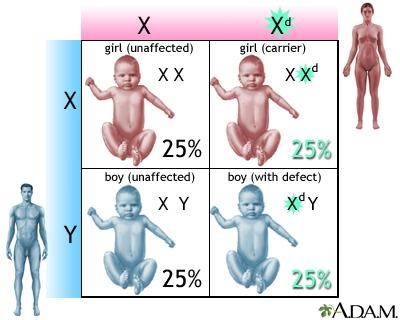Scientists attempt to cure Duchenne Muscular Dystrophy

October 3, 2019
Duchenne Muscular Dystrophy (DMD) is an inherited disorder that causes muscle weakness and physical impairments.
It is caused by a mutated gene that produces protein for muscles, known as dystrophin. The gene is passed down from mother to son.
Although DMD is inherited, there could be no signs of the disorder from previous generations. The defective gene is X-linked recessive.
Males inherit X- chromosome from their mothers and a Y- chromosome from their fathers.
If the mother is a carrier of the mutated gene, there is a 50% percent chance for it to be active or inactive. In turn, it will be a 100% chance that it will be expressed in sons. Because daughters inherit X-chromosome each from both their mom and dad, there is a 50 % chance they will be carriers of the mutation.
Symptoms of the disordrr are shown as early as infancy to about six years old. Some symptoms include difficulty with motor skills, learning disabilities, trouble breathing, and a gradual decrease in muscle use.
As a result of muscle weakening in the heart and lungs, congestive heart failure and pneumonia most definitely is a high possibility. There are is no cure for DMD, yet there have been treatments used to slow/control symptoms and improve the quality of life.
For example, muscle loss in the lungs affects breathing, therefore, an inhaler is given to relax the muscle creating a path for oxygen to go through. At the University of Missouri School of Medicine, scientist have developed an experiment to investigate whether or not CRISPR could be used to reverse the mutation.
CRISPR is a system in bacteria that contains a repeated sequence of genetic codes, that stores codes from foreign things that have encountered the bacteria.
CRISPR helps to identify and destroy foreign things that enter the cell. Through extensive research scientist have been able to artificially program CRISPR to detect specific DNA sequences and remove them.
Therefore, at the University of Missouri, scientist wanted to apply this to DMD to be able to use CRISPR to target mutated muscle stem cells to ensure that when replicated, the new cells won’t have the mutation at all. Stem cell are found in different organs and tissues, since DMD is a muscular disorder, they target the stem cells found in our muscles. In collaboration with researchers from John Hopkins, they wanted to test the theory by using a mouse model. Therefore, they introduced the mutated gene through a virus known as AAV9 using CRISPR, into a healthy mouse with healthy muscles.
As a result, the muscles cells died, healthy cells without the mutation regenerated, and there was an increase in dystrophin production.
Overall, they determined that CRISPR indeed is able to be used to target stem cells in DMD, which hopefully can lead to more scientific breakthroughs with other disorders in the future.
IMAGE COURTESY OF MT. SINAI









